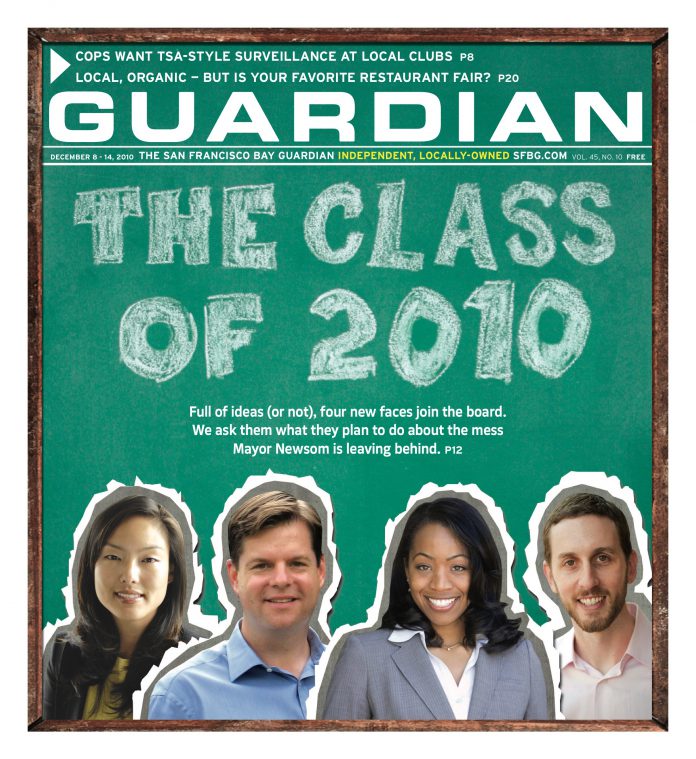arts@sfbg.com
HAIRY EYEBALL It can be easy to get cynical about the business side of art, so it’s always refreshing when a local labor of love such as Romer Young — the small Dogpatch gallery formerly known as Ping Pong — demonstrates that growth doesn’t necessarily entail compromising one’s vision.
That vision has always been driven by husband and wife team Vanessa Blaikie and Joey Piziali’s commitment to work that is consistently smart, challenging and often surprisingly personal: from recent Goldie winner Amanda Curreri’s conceptual prompts at forging new social connections, to, most recently, James Sterling Pitt’s table-full of sculpted art-related books and ephemera, an affectionate take on how material possessions can shape creative practice.
“We’ve had very special relationships with our artists because this has always been about putting their work first,” explains Blaikie, when I meet with her and Piziali in the gallery’s cozy back room, which adjoins Piazali’s studio. Inspired by the work of many of their classmates in San Francisco Art Institute’s MFA program, but dismayed by the lack of spaces willing to take a chance on art that was more conceptual or performance-based, Blaikie and Piziali took matters into their own hands and started putting together exhibits.
The gallery’s unusual former name came from the quarterly, ping-pong happy hours Blaikie and Piziali held, a nod to 1970s Bay Area conceptual artist Tom Marioni’s famous statement, “Drinking beer with friends is the highest form of art.”
“We were really trying to activate the space as social sculpture through a non-art event,” Piziali recalls, “but we also had our share of calls asking about equipment rentals.”
Five years later, as the partnerships Blaikie and Piziali formed early on have led to a roster of repeat-showers and a more prominent profile, they decided it was time to change names and reassess how best to shift their operation. “Once you’re not an exhibition space, you start looking at the model of ‘gallery’ and see what that means, “explains Piziali. “But you don’t start a space like this with blood, sweat, and tears only to ask every time, ‘Did we make the bottom line?'”
Though the paddles have been hung up in favor of the, let’s face it, more professional-sounding Romer Young — a combination of Blaikie and Piziali’s mothers’ maiden names — Blaikie’s and Piziali’s core commitment hasn’t changed. Fittingly, they have decided to inaugurate the newly christened space with a solo exhibit by the now New York City-based conceptual artist Chad Stayrook, who contributed one of Ping Pong’s earliest shows.
“It felt only right to honor the growth we’ve undergone,” reflects Blaikie. “When we started, we were doing it because we loved it, and now we’re doing it because we love it and we want it to make sure it can keep growing.”
DOWN MEXICO WAY
Upon entering “Disponible — a kind of Mexican show” at SFAI’s Walter and McBean Galleries, you hear Manuel Rocha Iturbide’s sound installation I play the drum with frequency before you see it — what you see is Hector Zamora’s massive arrangement of hanging metal drying racks. Suspended with fishing line in tiered formations, the drying racks play off of the Brutalist, concrete interior of the Walter gallery while imbuing the space with an ethereal density. The ricocheting clinks, low-end buzzes, and sonorous clangs emitted by Iturbide’s piece — installed in a lofted area above the main gallery — bring Zamora’s installation to life as a fog bank-turned-carousel organ.
Both pieces are less impressive, however, when you attempt to view them individually. Without the extra visual accompaniment, Iturbide’s deconstructed drum kit — played via algorithmically-controlled speaker cones whose vibrations sound the cymbals and drum heads they’re attached to — loses its initial impact. Likewise, separated from Iturbide’s soundtrack, Zamora’s piece resembles the forgotten remains of a half-finished install job.
This creeping feeling of “is that all there is?” that both Zamora’s and Iturbide’s pieces evokes seems, at least partially, by design. The exhibit takes its name from the text on empty advertising billboards throughout Mexico, in which disponible is followed by a phone number. Playing off the double meaning of disponible as “available” and also “potentially changeable” or “disposable,” the curatorial team of Hou Hanru, SFAI’s director of exhibitions and public programs, and Guillermo Santamarina, an independent curator based in Mexico City, aren’t so much devaluing the pieces they’ve selected as they are loosening the conceptual strictures implicit in putting on a show of contemporary Mexican art. I can’t wait to see what Hanru and Santamarina have in store for phase two of the exhibit, which opens in February.
CHAD STAYROOK: UNATTAINABLE BEAST
Fri/10 through Jan. 15, 2011
Romer Young Gallery
1240 22nd St., SF
(415) 550-7483
DISPONIBLE — A KIND OF MEXICAN SHOW (PHASE ONE)
Through Jan. 22
Walter and McBean Galleries, San Francisco Art Institute
800 Chestnut, SF
(415) 749-4563

